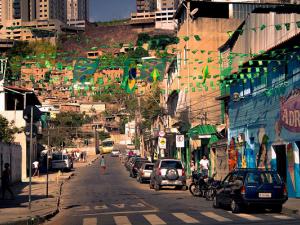Since the opening match on 12 June 2014, the world’s eyes have been glued to Brazil as nations follow their teams’ progress through the World Cup. But behind the football lies a middle income country battling many problems including poverty and human rights.
Rooney has been a hairdresser since 1988 but he is also a prisoner. Jailed for homicide, he currently resides in an APAC prison in Belo Horizonte, the capital of the Brazilian state of Minas Gerais. “This is the fourth [prison] that I have lived in,” says Rooney. “The difference is that here we are treated with dignity. They call us by our names and we are properly prepared for reintegrating into society and seeing our families again.”
Brazilian prisons house some of the largest prison populations in the world and are often featured in the news for human rights violations as many prisons suffer from overcrowding and violence. The APAC system is very different. Since the 1970s, the Associação de Proteção e Assistência aos Condenados (Association for the Protection and Assistance to the Convicted) has been dedicating itself to the “recovery and social reintegration” of convicts.
APAC prisons are run by civil society and are marked by their lack of police presence, guns and prison guards. Instead safety and discipline are managed by the prisoners themselves with assistance from support staff, typically volunteers. Prisoners are expected to involve themselves in the community and to rehabilitate through a programme of ‘valorização humana’ or human valorisation by developing 12 elements including spiritualisation, education, work, and family. The aim is to show them that they can play a role in society and that they are useful, explained Luiz Carlos Rezende e Santos, a Member of the Conselho Nacional de Justiça.
“This is a very cheap method because the main partners are the community itself,” explained Mr Santos. “It’s a method that costs a third of the price of conventional prisons.”
Prisoners are carefully selected to ensure the sustainability of the model: they must have already been incarcerated in another prison for at least a year and they must show signs of remorse for their crimes. However, perhaps most important of all is the fact that prisoners are sent to APAC prisons as close as possible to their home communities, and their families are involved in their rehabilitation.
It is also a method that appears to work very well. “In the APAC there is no violence, there are no crimes, there is no corruption. Until now no prisoners have died in an APAC. So in my opinion this is something that we should reflect on, they are doing something right,” said Maria Rosa Sabbatelli, speaking at the European Development Days last year, where the APAC system was discussed in a lab session on Promoting prisoners’ human rights. Ms Sabbatelli is a Programme Manager at the European Union Delegation to Brazil.
Furthermore prisoners exiting the traditional prison systems have a very high reoffending rate, more than 70%, whereas only 10% of prisoners leaving the APAC system commit repeat offenses. “Among the 10% who do go back to jail we have observed that in the majority of cases the crimes that they commit are less serious than the ones that they were originally incarcerated for,” concluded Mr Santos, who believes that this is proof of the model’s success.
The Brazilian authorities are currently considering expanding this project to other cities. Ms Sabbatelli noted the importance of this project for the European Union (EU) is that “it is something that we can replicate in other countries, not only in Latin America but also in Europe. There are many similar models already in place, but operating under different methodologies. The next step will be to see how to integrate these models with the APAC methodology.”
|
The European Commission (EC) has been supporting the APAC system since 2011 through the framework of two programmes: EUROsociAL and the European Instrument for Democracy & Human Rights (EIDHR). A pilot project was launched in one of the prisons in Minas Gerais where the EIDHR provided 149,900 euros over two years. In the last three years the EU Delegation has managed 26 projects totalling 5,070,056 euro under the EIDHR programme. |
Patrice Lenormand is Deputy Head of Unit for the Governance, Democracy, Gender, Human Rights Unit at EuropeAid. He too believes that the APAC system has a lot of potential: “It is an excellent project in terms of human rights because it is improving the situation of human rights in prisons and you know the condition of the 500,000 prisoners in Brazil is hell. If you go to prison you go to hell.”
However, Mr Lenormand is not sure how well the project would translate to other countries as the APAC system requires significant support from the authorities. “There is no reason why we could not do it in Mexico, they have similar problems of gangs, of prisons, of violence. But the strong point in Brazil has been the strong involvement of the judiciary system. One point on human rights in Brazil is that the human rights legislative framework is very good on paper. Most of the problems lie in transferring this framework to local level. So yes, we could extend [the APAC system] to other areas of Brazil, and discuss the possibility [of extending it] to other countries.”
He concluded by saying that “this type of thing needs to be very carefully assessed and checked, but if any [EU] Delegation from any country thinks we should do it, that’s something we would be very happy to test.”

The APAC project is currently being featured as part of an information campaign surrounding the World Cup. The Governance, Democracy, Gender, Human Rights Unit of EuropeAid is working in collaboration with the EU Delegation to Brazil to showcase the work that they’re doing in Brazil through the EIDHR programme.
The campaign has three elements and is centred around the 12 match cities:
- There is a fact sheet for each one containing information on the city itself as well as featuring a key EU project being implemented there.
- Five short videos were created delving deeper into the key projects in the cities hosting the final matches.
- A media campaign against sexual tourism focusing in particular on children.
In the following video Mr Lenormand explains the projects were selected, as well as addressing the benefits of communication campaigns for the European Union. He believes that communicating on projects and results is how you maintain the flow and attraction of a project, as well as gaining political leverage. “If you do not communicate on what you do, that’s how you get budget cuts”
This is not the first time that such a campaign has been attempted. In 2010, Mr Lenormand was part of a team, which tried to create a campaign around the South African world cup. They took a different approach targeting the football federation, FIFA, directly. However, they discovered that FIFA has a purely commercial approach and was not interested in a collaboration.
Looking forward to future sporting events Mr Lenormand is not sure if they will run such a campaign again. “First you should not do the same thing all the time. When you are in communication you need to change from time to time.” He also explained that such a large-scale campaign requires investment from several departments across the EC: the human rights, communication, and geographical units all need to be on board as well as the Delegation. “But it’s clear that the World Cup in Qatar has a human rights aspect which is strong, so we will have to do something in this area.”
In the short term the European Year for Development will take place next year “so I think we might focus more on the development aspect of our work. It is a unique chance to communicate on EuropeAid work as well. But communicating on results yes [we need to do this] all the time.”
Visit the capacity4dev group on Security, Justice & Human Rights where you can watch all the campaign videos and find out more about the EIDHR. You can also view a video where Mr Lenormand explains the campaign in more detail.
View the press release for the campaign by clicking here.
This collaborative piece was drafted with input from Patrice Lenormand and the EU Delegation to Brazil, with support from the capacity4dev.eu Coordination Team. Teaser image courtesy of alobos Life.


Log in with your EU Login account to post or comment on the platform.